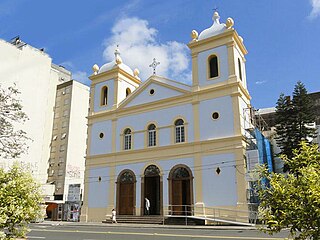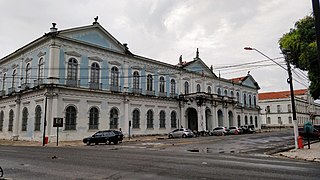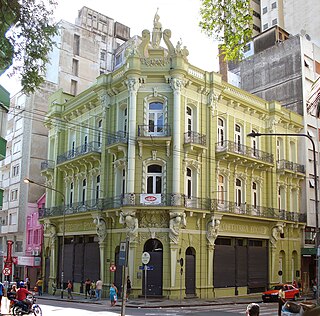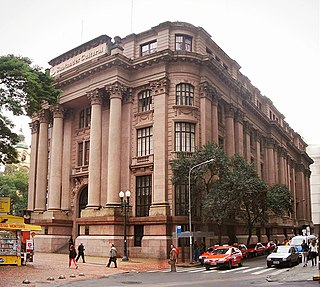
Picada Café or Kaffeeschneiss in the local German dialect is a municipality in the state of Rio Grande do Sul, Brazil. It is located around 80 kilometers from the state capital of Porto Alegre.

Centro Histórico is a neighborhood of the city of Porto Alegre, the state capital of Rio Grande do Sul in Brazil.

The Legislative Assembly of Rio Grande do Sul is the regional parliament of Rio Grande do Sul, a federative unit in Brazil. It has 55 state deputies elected every 4 years.

The Godoy House is a historic building on Independência Avenue in the city of Porto Alegre, Rio Grande do Sul, Brazil. The house is one of the rare remaining buildings in the Art Nouveau style in Porto Alegre, dating from 1907.
The following is a timeline of the history of the city of Porto Alegre, in the state of Rio Grande do Sul, Brazil.

With a history of over two centuries, the architecture of Porto Alegre, the capital of Rio Grande do Sul, in Brazil, is a mosaic of ancient and modern styles. This characteristic is most visible in the center of the city, the historic urban center, where examples of eighteenth-century architecture survive amidst nineteenth-century and contemporary buildings.

The Historic Center of Caxias do Sul is a Special Sector of the city contemplated in its General Plan and regulated by specific legislation. It comprises the region that was first urbanized, located around the Dante Alighieri square and limited by the streets Os 18 do Forte, Bento Gonçalves, Alfredo Chaves, and Moreira César. The Historic Center has been the vital core of Caxias do Sul since its origin and has undergone profound changes since the early days, but it still preserves its original urban layout and a number of buildings of great architectural and historical interest. However, it has suffered from frequent traffic jams and the degradation of some stretches.

The Piratini Palace is the current seat of the Executive Branch of the Brazilian state of Rio Grande do Sul. It is located at Marechal Deodoro Square, also known as the Mother Church Square, in Porto Alegre's historic center. The Piratini Palace has been the official residence of thirty-eight governors.

The Church of Our Lady of the Conception is a temple of the Catholic Church located on Independência Avenue, in front of the Dom Sebastião Square, in Porto Alegre, Brazil. It is one of the oldest churches in the city and the one that best preserves its original appearance, containing a rich internal decoration in gilded woodcarving and statuary, besides being a listed property by the City Hall.

The Palácio Antônio Lemos, also called the Belém Art Museum, is a public building, palace, museum, and the city hall of Belém, built in 1860 by José da Gama Abreu, in the context of the rubber cycle. It is located in the Cidade Velha neighborhood.

Alfândega Square is a public, historic, and tourist attraction in the Brazilian city of Porto Alegre, capital of the state of Rio Grande do Sul.

Praça Marechal Deodoro, better known as Praça da Matriz, is a historic square in the city of Porto Alegre, the capital of the Brazilian state of Rio Grande do Sul. It is located in the heart of the city, in the Historic Center, and has existed since the early days of the capital. It is listed by the National Institute of Historic and Artistic Heritage.

The Eberle Palace is a historic building in Caxias do Sul, Brazil, located at 1540 Sinimbu Street. It was the residence of the important industrialist Abramo Eberle, and is protected by the City Hall.

The Igreja Matriz de Nossa Senhora da Conceição is a Brazilian Catholic temple located in the city of Viamão, state of Rio Grande do Sul. It is the second-oldest church in the state and the seat of the oldest parish of the Archdiocese of Porto Alegre. It is also the main architectural landmark of Viamão.

Confeitaria Rocco is a historic building located in Porto Alegre, capital of Rio Grande do Sul. It is situated on the corner of Riachuelo and Dr. Flores streets, next to Conde de Porto Alegre square, formerly Praça do Portão. For its historical importance, it is listed as a heritage site by the City Hall of Porto Alegre.

The Ely Building is a historic construction located in the Brazilian city of Porto Alegre, capital of Rio Grande do Sul, considered a cultural heritage of the city.

The Rio Grande do Sul Memorial is a cultural center in Porto Alegre, housed in a historic property located in Alfândega Square, in the city's historic center. It is a building listed as historical heritage by the City Hall and by the National Institute of Historic and Artistic Heritage.

The Historic Center of Antônio Prado, a Brazilian city in the state of Rio Grande do Sul, preserves a rich historical heritage dating back to its origins. Antônio Prado was founded in 1886, primarily by Italian immigrants, and soon became a bustling commercial hub. However, in the 20th century, it underwent a decline, which was, nevertheless, instrumental in preserving the largest and most significant urban architectural ensemble of Italian colonization in Brazil, designated as a historical and artistic landmark by the National Institute of Historic and Artistic Heritage.

Farol Santander Porto Alegre, formerly known as Santander Cultural, is a Brazilian cultural center run by Banco Santander. It is located in a historic building in Alfândega Square, in the Brazilian city of Porto Alegre, in Rio Grande do Sul. It has been listed as a heritage site by IPHAE.

Clube do Comércio is based in the Brazilian city of Porto Alegre, in the state of Rio Grande do Sul. Founded in 1896, it is one of the city's most traditional clubs. The headquarters, located on Andradas Street, was listed as a landmark site by the Porto Alegre City Hall in 1996.




















